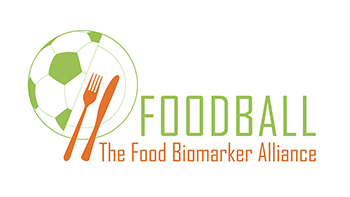To investigate the relationship between diet and health in epidemiological studies, it is necessary to record food consumption as accurately as possible. Classical dietary survey methods are predominantly based on interviews with study participants and suffer from the associated inaccuracies such as incorrect estimation of portion sizes and incomplete information on consumed food.
The aim of the "Food Biomarker Alliance" (FOODBALL) is to identify so-called (bio)markers of food intake, i.e. food constituents or their metabolites in blood and urine, which are characteristic for the consumption of a certain food. In the future, these biomarkers can be used to complement the data of classical dietary survey methods, e.g. in cohort studies or cross-sectional studies, and thus enable a more accurate assessment of dietary intake.
To date, only a few biomarkers of food intake are known and sufficiently validated. FOODBALL, a project under the Joint Programming Initiative "A healthy diet for a healthy life" (JPI HDHL), aims to fill this knowledge gap. The FOODBALL consortium consists of 22 cooperation partners from ten European countries as well as Canada. Therefore, there is access to sample materials and data from large cohort studies. In addition, through the various partners, there is almost unlimited access to modern metabolomics platforms that allow the measurement of thousands of metabolites and thus potential markers. This provides unique conditions in FOODBALL to identify new valid biomarkers of food intake. To this end, the literature on already described (bio)markers of food intake was systematically reviewed in a first step and review articles on different food groups and potential biomarkers were published.
The Max Rubner Institute contributed to the following review articles:
- Rothwell, J.A., Madrid-Gambin, F., Garcia-Aloy, M. et al. Biomarkers of intake for coffee, tea, and sweetened beverages. Genes Nutr 13, 15 (2018). https://doi.org/10.1186/s12263-018-0607-5
- Sri Harsha, P.S.C., Wahab, R.A., Garcia-Aloy, M. et al. Biomarkers of legume intake in human intervention and observational studies: a systematic review. Genes Nutr 13, 25 (2018). https://doi.org/10.1186/s12263-018-0614-6
Online resources are an important tool to identify metabolites beyond doubt, which is still a major challenge. Therefore, the FOODBALL project also developed a comprehensive database of food ingredients and their metabolites called Food Metabolome Database (FoodDB). Furthermore, the online Food Compound Exchange (FoodComEx) was created to facilitate the exchange of analytical standards that are hard-to-obtain between research institutions.
One focus of the experimental work to identify new biomarkers of food intake was the performance of short-term intervention studies. Here, healthy men and women in strictly controlled studies ingested a specific food (e.g., a serving of milk, chicken meat, or tomatoes) on a one-time basis. In the following 48 hours, blood and urine samples were collected from the subjects, which were analyzed using untargeted metabolomics methods, in particular so-called "metabolite profiling" methods. By comparing the metabolite profiles in blood and urine of the subjects before and after consumption of the selected food, metabolites that might be characteristic of ingestion were identified. Using samples or data from previously conducted (cohort) studies, the new potential food consumption (bio)markers were then validated and classified.
At the Max Rubner Institute, apples and cola beverages were the investigated foods. Samples were analyzed by GC×GC-MS, HS-SPME-GC-MS and NMR metabolite profiling methods at MRI and by LC-MS/TOF by Italian colleagues (Fondazione Edmund Mach - FEM). The figure below shows some potential consumption markers for apples and cola beverages. These will be subsequently validated using data from the KarMeN study, a cross-sectional study with 301 subjects. This means that the marker candidates are examined in the urine or blood samples of the participants and it is tested whether the association between the consumption of the examined food and the marker candidate in urine or blood in a free-feeding population can be reproduced.
In addition, the Max Rubner Institute participated in the measurement of the short-term intervention studies of the French colleagues (Institut national de la recherche agronomique - INRAe), in whose study bananas and tomatoes were consumed, in the investigation of the sugar profile of the short-term intervention study of the Munich colleagues (Technical University of Munich - TUM), in whose study toast, rice, and two dietary fibers (inulin and ß-glucan) were examined, and in the characterization of the metabolome of all foods used in a wide variety of short-term intervention studies.
The following publications have already been published with partners as part of the FoodBAll project:
- Ulaszewska, M. M., Weinert, C. H., Trimigno, A., Portmann, R. et al. Nutrimetabolomics: An Integrative Action for Metabolomic Analyses in Human Nutritional Studies. Mol. Nutr. Food Res. 63, 1800384 (2018). https://doi.org/10.1002/mnfr.201800384
- Natalia Vázquez-Manjarrez, Christoph H Weinert, Maria M Ulaszewska, Carina I Mack et al. Discovery and Validation of Banana Intake Biomarkers Using Untargeted Metabolomics in Human Intervention and Cross-sectional Studies. J. Nutr., 149, 10 (2019). https://doi.org/10.1093/jn/nxz125
- Garcia-Aloy, M., Ulaszewska, M., Franceschi, P., Estruel-Amades, S. et al., Discovery of Intake Biomarkers of Lentils, Chickpeas, and White Beans by Untargeted LC–MS Metabolomics in Serum and Urine. Mol. Nutr. Food Res. 64, 1901137 (2020). https://doi.org/10.1002/mnfr.201901137



